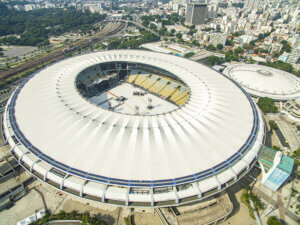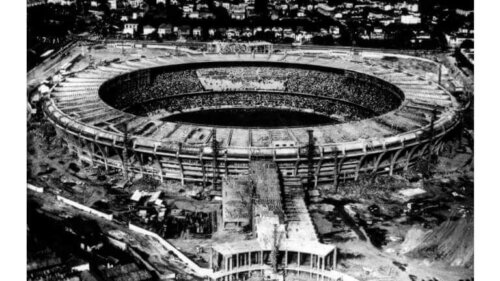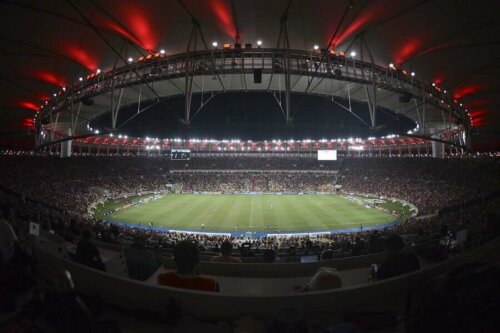The Legendary Rio de Janeiro Maracanã Stadium

Every soccer fan knows that the Maracanã stadium in Rio de Janeiro is something special. For a long time, it was even the biggest in the world, or, “O mais grande do mundo”, as they say in Brazil. While it was built for the 1950 World Cup, it continues to be the stuff of legends. Today, we’ll tell you a little bit more about this incredible structure.
The history of Maracanã
Originally, the name of the stadium was The Municipal Stadium of Maracanã (“green bird” in Tupi-Guarini). It opened on June 24th, 1950, with a Brazil vs. Mexico 4-0 blowout. After that, there would be other group stage matches and finales.
It was even the site of the famous final between Brazil and Uruguay. The event has come to be known as the “Maracanazo,” because the Uruguayan team overcame the odds and beat Brazil in the World Cup Final 2-1. Over 200,000 people filled the stadium, a record that’s yet to be beaten.
The Maracanazo happened on July 16th, 1950. It was the second (and last, so far) World Cup title for the Uruguayan national team.
After the World Cup, the Maracanã became the home of two local teams, the Flamengo and the Fluminense. This is one of the curious examples of rival teams who share a stadium. In 1963, the class Fla-Flu game broke another attendance record with more than 194,000 spectators.

A year later, the government decided to change the name to Mario Filho in honor of a Brazilian sports journalist. Filho was the founder of Jornal dos Sports, a local newspaper. Though its name is different, locals still call it Maracanã.
Many globally-famous soccer starts have stepped foot inside the mythical stadium, among them Pele, Maradona, Ronaldo, and some more recent ones, Messi and Riquelme.
In 1989, it was once again the site of a renowned sporting event, the Copa America. The six games that were held in the Maracanã were part of the final stage.
Renovations and changes
In 1992, during a Flamengo vs. Botafogo (another great Rio de Janeiro team) game, a set of stadium seats collapsed and fell on hundreds of spectators; three of them died. After the accident, they decided to remodel the stadium and change the seating capacity to 130,000.
They also made some changes later to be able to host the Club World Cup that Corinthians won. They first had to reduce the seating capacity to 103,000, but they ended up reducing it even further to meet the FIFA rule that all fans had to be seated. The seating capacity after that change went down to 80,000 people.
Today, the stadium measures 32 meters at its highest point. The perimeter measures 800 meters, it has an opening at the top with no visible support structure. To celebrate the year 2000, they opened the Hall of Fame, honoring the first 50 years of this iconic giant. Many soccer greats left their footprints for posterity.
In 2012, Maracanã had another change: they added a cover of solar panels in order to supply all the electricity for the stadium. The energy that’s produced by the solar panels is actually enough that they can even provide extra for the city. A year later, three FIFA Confederations Cups were held there. In 2014, they remodeled it again for the World Cup.
While the stadium still has its original color – light blue – and facade, it’s oval shape was slightly altered to make it more modern. They also added restaurants, new ramps, escalators, and better access. They enlarged the parking lot and knocked out the upper level of seating for better visibility.

The Maracanã stadium in recent international events
The Maracanã was the site of seven world Cup games in 2014, including the final where Germany beat Argentina 1-0. The last international match that took place in the stadium was the 2019 Copa America. Brazil won the championship after winning 3-1 over Peru in the final to a crowd of nearly 70,000 people.
To conclude, it’s worth mentioning that many famous musicians have also performed in Maracanã. Queen, Madonna, Kiss, U2, Tina Turner, Aerosmith, and Frank Sinatra have all given concerts there. Have you ever thought about visiting this wonderful place?
Every soccer fan knows that the Maracanã stadium in Rio de Janeiro is something special. For a long time, it was even the biggest in the world, or, “O mais grande do mundo”, as they say in Brazil. While it was built for the 1950 World Cup, it continues to be the stuff of legends. Today, we’ll tell you a little bit more about this incredible structure.
The history of Maracanã
Originally, the name of the stadium was The Municipal Stadium of Maracanã (“green bird” in Tupi-Guarini). It opened on June 24th, 1950, with a Brazil vs. Mexico 4-0 blowout. After that, there would be other group stage matches and finales.
It was even the site of the famous final between Brazil and Uruguay. The event has come to be known as the “Maracanazo,” because the Uruguayan team overcame the odds and beat Brazil in the World Cup Final 2-1. Over 200,000 people filled the stadium, a record that’s yet to be beaten.
The Maracanazo happened on July 16th, 1950. It was the second (and last, so far) World Cup title for the Uruguayan national team.
After the World Cup, the Maracanã became the home of two local teams, the Flamengo and the Fluminense. This is one of the curious examples of rival teams who share a stadium. In 1963, the class Fla-Flu game broke another attendance record with more than 194,000 spectators.

A year later, the government decided to change the name to Mario Filho in honor of a Brazilian sports journalist. Filho was the founder of Jornal dos Sports, a local newspaper. Though its name is different, locals still call it Maracanã.
Many globally-famous soccer starts have stepped foot inside the mythical stadium, among them Pele, Maradona, Ronaldo, and some more recent ones, Messi and Riquelme.
In 1989, it was once again the site of a renowned sporting event, the Copa America. The six games that were held in the Maracanã were part of the final stage.
Renovations and changes
In 1992, during a Flamengo vs. Botafogo (another great Rio de Janeiro team) game, a set of stadium seats collapsed and fell on hundreds of spectators; three of them died. After the accident, they decided to remodel the stadium and change the seating capacity to 130,000.
They also made some changes later to be able to host the Club World Cup that Corinthians won. They first had to reduce the seating capacity to 103,000, but they ended up reducing it even further to meet the FIFA rule that all fans had to be seated. The seating capacity after that change went down to 80,000 people.
Today, the stadium measures 32 meters at its highest point. The perimeter measures 800 meters, it has an opening at the top with no visible support structure. To celebrate the year 2000, they opened the Hall of Fame, honoring the first 50 years of this iconic giant. Many soccer greats left their footprints for posterity.
In 2012, Maracanã had another change: they added a cover of solar panels in order to supply all the electricity for the stadium. The energy that’s produced by the solar panels is actually enough that they can even provide extra for the city. A year later, three FIFA Confederations Cups were held there. In 2014, they remodeled it again for the World Cup.
While the stadium still has its original color – light blue – and facade, it’s oval shape was slightly altered to make it more modern. They also added restaurants, new ramps, escalators, and better access. They enlarged the parking lot and knocked out the upper level of seating for better visibility.

The Maracanã stadium in recent international events
The Maracanã was the site of seven world Cup games in 2014, including the final where Germany beat Argentina 1-0. The last international match that took place in the stadium was the 2019 Copa America. Brazil won the championship after winning 3-1 over Peru in the final to a crowd of nearly 70,000 people.
To conclude, it’s worth mentioning that many famous musicians have also performed in Maracanã. Queen, Madonna, Kiss, U2, Tina Turner, Aerosmith, and Frank Sinatra have all given concerts there. Have you ever thought about visiting this wonderful place?
All cited sources were thoroughly reviewed by our team to ensure their quality, reliability, currency, and validity. The bibliography of this article was considered reliable and of academic or scientific accuracy.
- Olé – La fiesta de Flamengo en el Maracaná – Noviembre 2019 – https://www.ole.com.ar/futbol-internacional/brasil-maracana-flamengo-fiesta_0_GeV1e8U6.html
- Angulo, A – Así es el estadio de Maracaná – MARCA – Junio 2019 – https://www.marca.com/futbol/copa-america/2019/06/04/5cd97ef1ca474157098b45db.html
This text is provided for informational purposes only and does not replace consultation with a professional. If in doubt, consult your specialist.








